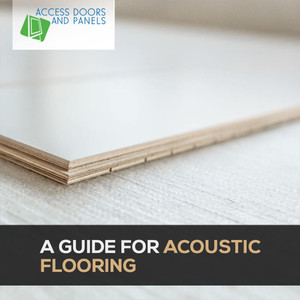A Guide for Acoustic Flooring
Posted by Access Doors and Panels on 16th Jun 2021
Acoustic flooring is a consideration in every vital design element, whatever the industry, to enhance the sound quality or reduce noise distraction. Choosing suitable materials for effective sound treatment is crucial. Installing acoustic flooring and soundproof access panels are practical and efficient ways of preventing sound transmission and reducing background noise.
You can read additional information here: "Sound Proof Access Panels - What You Need To Know."
Types of Noise Acoustic Flooring Can Intercept
The noise in the building is either absorbed or transmitted by the ceiling, wall, and flooring. The objective of the sound treatment is to enhance the quality of sound and speech within rooms by reducing background noise and block sound transmission inside rooms and floors. Here are those noises:
#1. Airborne Sound
People, speakers, and instruments are the most common sources of airborne sound. Sound waves are taken up by the air and carried until they collide with something solid, such as a wall. Vibrations travel through the wall and into the room behind it as a result of the collision. Airborne sound, like impact sound, can travel through your flooring and into other areas of the building.
#2. Impact Sound
Floors take the brunt of impact inside the building, whether from foot traffic, carts, or vibrating machinery. The sound energy caused by the collision can be transmitted through your building's structure, causing noise distortion and disturbing staff, visitors, or residents. Acoustic flooring aims to isolate impact noise.
Top 5 Best Suited Materials for Sound Treatment
There are five materials considered as the best choice for sound treatment for most buildings. Before doing anything or deciding on what type of flooring you want, have a professional advise you to ensure that the material is genuinely suited for your building. The professional can also walk you through the process and help you see other factors you might miss.
#1. Vinyl Tile
Vinyl tile, installed with a sound-insulating underlayment, especially luxury vinyl tile (LVT), is an excellent sound-absorbing flooring choice. Many facilities choose it because of its design flexibility, reliability, and low maintenance costs.
#2. Wood Plastic Composite (WPC) Flooring
WPC flooring is durable, waterproof, and easy to maintain, and has excellent acoustic properties, particularly when it comes to reducing impact noise from high foot traffic. The backing layer, which provides sound insulation and protects against mold and mildew, is responsible for most acoustic benefits.
#3. Carpet
Carpet or carpet tiles are renowned for their ability to absorb impact sound, making them ideal for hotels, schools, and offices. Carpets with a higher pile or a thick pad underneath are particularly effective at absorbing sound and reducing transmission.
#4. Rubber Flooring
The sound-absorbing properties of commercial rubber flooring are well-known. It's also anti-slip, anti-mold, and anti-mildew. It's an excellent option for hospitals, classrooms, gyms, and kitchens in need of long-lasting acoustic flooring.
#5. Cork Flooring
Cork flooring is a long-lasting, convenient, and sound-absorbing flooring alternative that works well in various commercial settings. It is, however, often used as an underlay to provide acoustic insulation due to its ability to stain and indent.
Conclusion
Acoustic flooring effectively prevents sound from traveling from an upper to a lower floor. When combined with the ceiling and wall coverings, this flooring system will help create the best acoustic atmosphere for the building. If you are unsure or you need help, consider contacting professionals who can aid you with your decisions.

